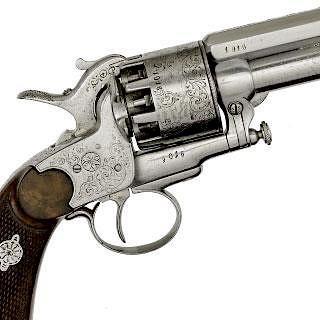First Model Henry Rifle Inscribed D.W. Jones
About Seller
6270 Este Ave.
Cincinnati , OH 45232
United States
With offices in Cincinnati, Cleveland and Denver, Cowan’s holds over 40 auctions each year, with annual sales exceeding $16M. We reach buyers around the globe, and take pride in our reputation for integrity, customer service and great results. A full-service house, Cowan’s Auctions specializes in Am...Read more
Two ways to bid:
- Leave a max absentee bid and the platform will bid on your behalf up to your maximum bid during the live auction.
- Bid live during the auction and your bids will be submitted real-time to the auctioneer.
Bid Increments
| Price | Bid Increment |
|---|---|
| $0 | $25 |
| $500 | $50 |
| $1,000 | $100 |
| $2,000 | $250 |
| $5,000 | $500 |
| $10,000 | $1,000 |
| $20,000 | $2,500 |
| $50,000 | $5,000 |
| $100,000 | $10,000 |
About Auction
Apr 26, 2016 - Apr 28, 2016
Cowan's Auctions dawnie@cowans.com
- Lot Description
.44 rimfire caliber, 24" octagonal barrel length with magazine tube, S/N 1763, top of barrel marked in two lines Henry Patent Oct. 16, 1860 over Manufact'D By The New Haven Arms Co. New Haven, CT.. D.W. Jones non-factory inscribed on the left side of the frame. Rear buck horn sight in the second notch on the frame. Blue barrel, magazine tube, hammer, trigger and lever with brass frame and butt plate. Oil stained walnut butt stock.
Research shows there are numerous men named "D.W.Jones" who served in either the Union or Confederate armies, yet considering the high cost to purchase a Henry rifle in the 1860s, this number is substantially narrowed to a few officers who could afford to purchase one or to an enlisted man who may have purchased one of these iconic weapons. The field of possibilities narrowed to four - two Confederate and two Federal. The Confederates are Colonel Dudley W. Jones, 9th Texas Cavalry (whose National Archives service records accompany the lot) and a D.W. Jones who served as Assistant Surgeon in both the 36th and 37th Mississippi Infantries. Both of these regiments served in the Western Theatre with assignments to the Armies of Mississippi and Tennessee.
The two federals matching these initials are: Captain Daniel W. Jones of Co. A, 27th Ohio Infantry and oddly, an enlisted man by the same name who served in Co. A, 2nd U.S.V.S.S. Although Berdan's Sharpshooters were not issued Henrys, one of their ranks may certainly have desired to own one. There are no additional details in the file to narrow these down, although the consignor believes this weapon was most likely owned by Col. Jones of the 9th Texas.
A native Texan, Jones was the grandson of an early settler and enlisted in 1861 in the Titus Grays of the 9th Texas Cavalry. He quickly rose through the ranks to Adjutant and later commanded the regiment for much of its service. Following the battle of Elkhorn Tavern in March 1862, the Ninth transferred to Ross' cavalry brigade, participating in more than thirty engagements. Following the war, Jones moved to Houston where he practiced law and published The Ku Klux Vidette, the city's first daily newspaper. Only a year later, he fell victim to yellow fever and died in the city.The barrel and magazine tube retain a lot of the blue finish with wear to the edges and muzzle. The hammer, trigger and lever all retain a lot of the blue finish blending to an overall dark patina. Markings are sharp and crisp. The brass frame has a mustard patina as well as the butt plate. The stock shows nicks and dings with a repair on the right side of the butt stock. Has a good bore. Mechanically functions, however, could use a tune up.Condition
- Shipping Info
-
SHIPPING. At the request of the buyer, Cowan's will authorize the shipment of purchased items. Shipments usually occur within two weeks after payment has been received. Shipment is generally made via UPS Ground service. Unless buyer gives special instructions, the shipping method shall be at the sole discretion of Cowan's Auctions, Inc.. Cowan's is in no way responsible for the acts or omissions of independent handlers, packers or shippers of purchased items or for any loss, damage or delay from the packing or shipping of any property.
-
- Buyer's Premium



 EUR
EUR CAD
CAD AUD
AUD GBP
GBP MXN
MXN HKD
HKD CNY
CNY MYR
MYR SEK
SEK SGD
SGD CHF
CHF THB
THB


















